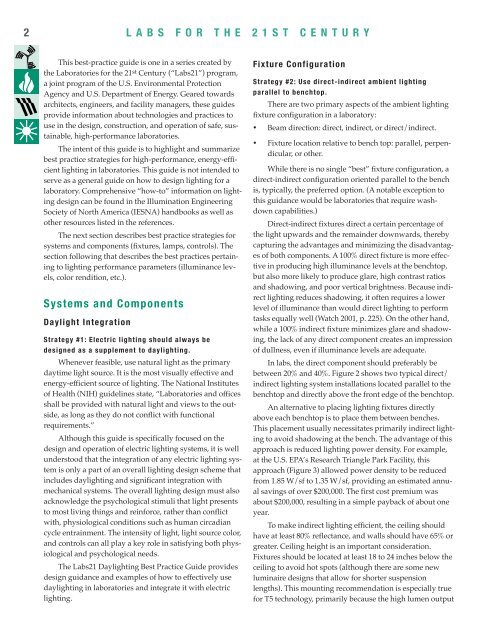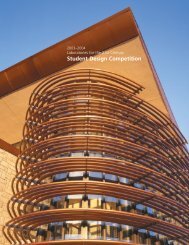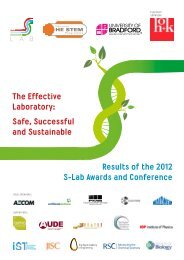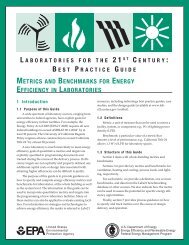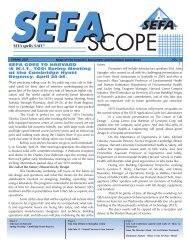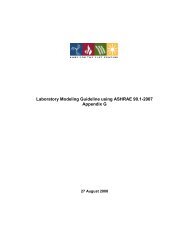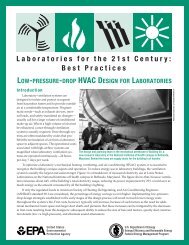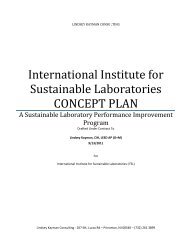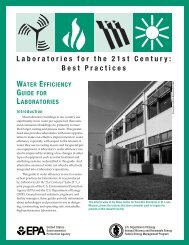EFFICIENT ELECTRIC LIGHTING IN LABORATORIES - I2SL
EFFICIENT ELECTRIC LIGHTING IN LABORATORIES - I2SL
EFFICIENT ELECTRIC LIGHTING IN LABORATORIES - I2SL
You also want an ePaper? Increase the reach of your titles
YUMPU automatically turns print PDFs into web optimized ePapers that Google loves.
2 L A B S F O R T H E<br />
2 1 S T C E N T U R Y<br />
<br />
<br />
This best-practice guide is one in a series created by<br />
the Laboratories for the 21 st Century (“Labs21”) program,<br />
a joint program of the U.S. Environmental Protection<br />
Agency and U.S. Department of Energy. Geared towards<br />
architects, engineers, and facility managers, these guides<br />
provide information about technologies and practices to<br />
use in the design, construction, and operation of safe, sustainable,<br />
high-performance laboratories.<br />
The intent of this guide is to highlight and summarize<br />
best practice strategies for high-performance, energy-efficient<br />
lighting in laboratories. This guide is not intended to<br />
serve as a general guide on how to design lighting for a<br />
laboratory. Comprehensive “how-to” information on lighting<br />
design can be found in the Illumination Engineering<br />
Society of North America (IESNA) handbooks as well as<br />
other resources listed in the references.<br />
The next section describes best practice strategies for<br />
systems and components (fixtures, lamps, controls). The<br />
section following that describes the best practices pertaining<br />
to lighting performance parameters (illuminance levels,<br />
color rendition, etc.).<br />
S y s t e m s a n d C o m p o n e n t s<br />
D a y l i g h t I n t e g r a t i o n<br />
S t r a t e g y # 1 : E l e c t r i c l i g h t i n g s h o u l d a l w a y s b e<br />
d e s i g n e d a s a s u p p l e m e n t t o d a y l i g h t i n g .<br />
Whenever feasible, use natural light as the primary<br />
daytime light source. It is the most visually effective and<br />
energy-efficient source of lighting. The National Institutes<br />
of Health (NIH) guidelines state, “Laboratories and offices<br />
shall be provided with natural light and views to the outside,<br />
as long as they do not conflict with functional<br />
requirements.”<br />
Although this guide is specifically focused on the<br />
design and operation of electric lighting systems, it is well<br />
understood that the integration of any electric lighting system<br />
is only a part of an overall lighting design scheme that<br />
includes daylighting and significant integration with<br />
mechanical systems. The overall lighting design must also<br />
acknowledge the psychological stimuli that light presents<br />
to most living things and reinforce, rather than conflict<br />
with, physiological conditions such as human circadian<br />
cycle entrainment. The intensity of light, light source color,<br />
and controls can all play a key role in satisfying both physiological<br />
and psychological needs.<br />
The Labs21 Daylighting Best Practice Guide provides<br />
design guidance and examples of how to effectively use<br />
daylighting in laboratories and integrate it with electric<br />
lighting.<br />
Fi x t u r e C o n f i g u r a t i o n<br />
S t r a t e g y # 2 : U s e d i r e c t - i n d i r e c t a m b i e n t l i g h t i n g<br />
p a r a l l e l t o b e n c h t o p .<br />
There are two primary aspects of the ambient lighting<br />
fixture configuration in a laboratory:<br />
• Beam direction: direct, indirect, or direct/indirect.<br />
• Fixture location relative to bench top: parallel, perpendicular,<br />
or other.<br />
While there is no single “best” fixture configuration, a<br />
direct-indirect configuration oriented parallel to the bench<br />
is, typically, the preferred option. (A notable exception to<br />
this guidance would be laboratories that require washdown<br />
capabilities.)<br />
Direct-indirect fixtures direct a certain percentage of<br />
the light upwards and the remainder downwards, thereby<br />
capturing the advantages and minimizing the disadvantages<br />
of both components. A 100% direct fixture is more effective<br />
in producing high illuminance levels at the benchtop,<br />
but also more likely to produce glare, high contrast ratios<br />
and shadowing, and poor vertical brightness. Because indirect<br />
lighting reduces shadowing, it often requires a lower<br />
level of illuminance than would direct lighting to perform<br />
tasks equally well (Watch 2001, p. 225). On the other hand,<br />
while a 100% indirect fixture minimizes glare and shadowing,<br />
the lack of any direct component creates an impression<br />
of dullness, even if illuminance levels are adequate.<br />
In labs, the direct component should preferably be<br />
between 20% and 40%. Figure 2 shows two typical direct/<br />
indirect lighting system installations located parallel to the<br />
benchtop and directly above the front edge of the benchtop.<br />
An alternative to placing lighting fixtures directly<br />
above each benchtop is to place them between benches.<br />
This placement usually necessitates primarily indirect lighting<br />
to avoid shadowing at the bench. The advantage of this<br />
approach is reduced lighting power density. For example,<br />
at the U.S. EPA’s Research Triangle Park Facility, this<br />
approach (Figure 3) allowed power density to be reduced<br />
from 1.85 W/sf to 1.35 W/sf, providing an estimated annual<br />
savings of over $200,000. The first cost premium was<br />
about $200,000, resulting in a simple payback of about one<br />
year.<br />
To make indirect lighting efficient, the ceiling should<br />
have at least 80% reflectance, and walls should have 65% or<br />
greater. Ceiling height is an important consideration.<br />
Fixtures should be located at least 18 to 24 inches below the<br />
ceiling to avoid hot spots (although there are some new<br />
luminaire designs that allow for shorter suspension<br />
lengths). This mounting recommendation is especially true<br />
for T5 technology, primarily because the high lumen output


